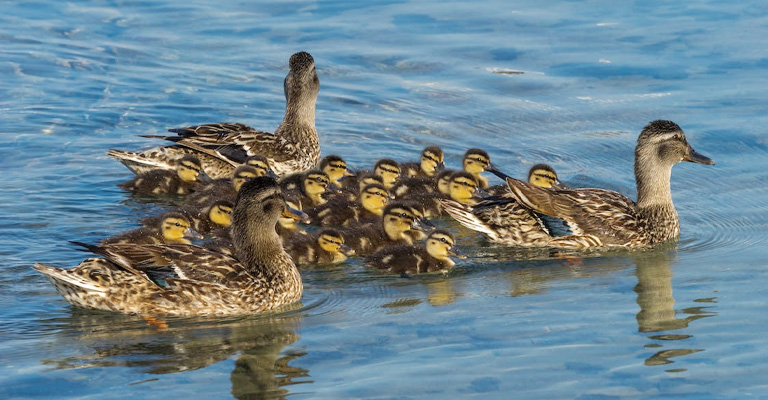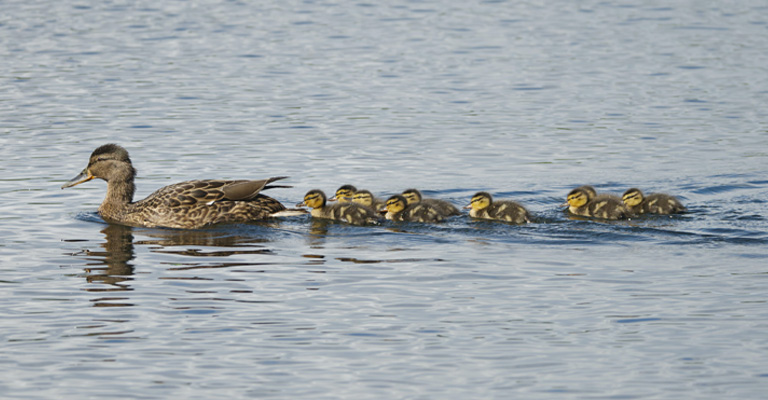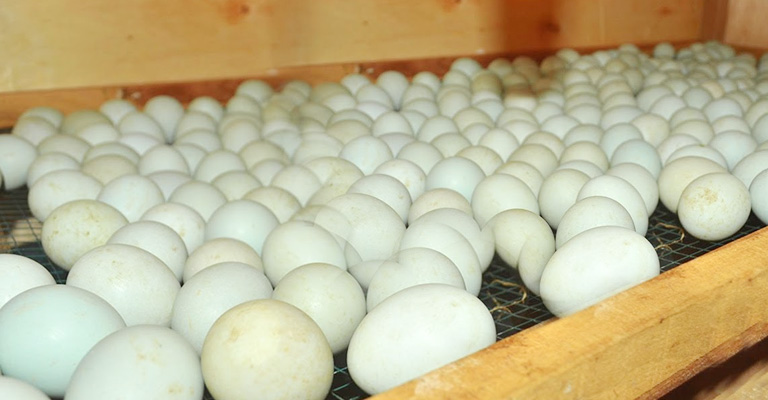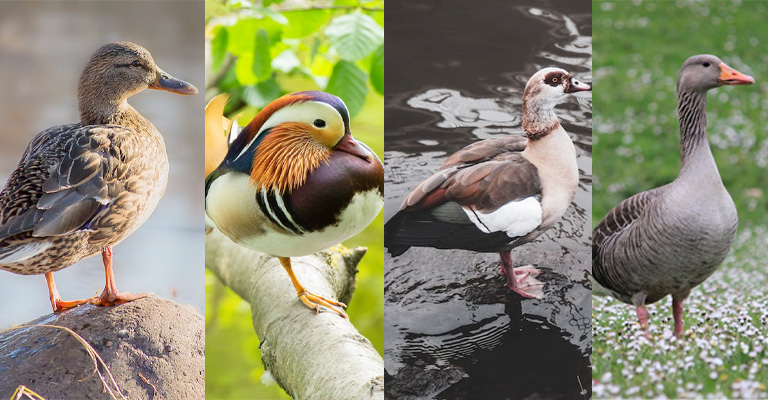The charm of ducklings following their mother in a neat row, especially in spring, is a delightful sight in the world of waterfowl. However, have you ever wondered how many ducklings a duck can have in a single brood?
The answer is not as straightforward as one might think, as the number of ducklings in a brood is influenced by a variety of factors, from the duck’s species to environmental conditions.
Understanding the factors that determine clutch size and the survival of ducklings is a fascinating aspect of avian biology.
In this exploration, we delve into the intriguing world of duck reproduction to uncover the range of factors that dictate how many ducklings a duck can have and the ecological significance of these feathered families.

How Many Ducklings Can A Duck Have?
The number of ducklings a duck can have can vary depending on the duck species and environmental factors. Generally, a typical clutch size for a duck ranges from 8 to 12 eggs.
However, the number of ducklings that survive to hatch and successfully fledge can be influenced by several factors, including the duck’s species, age, health, and the availability of food and nesting sites. Some species, like the mallard, are known to have larger broods, with up to 13 or more ducklings.
On the other hand, diving ducks, like the scaup, may have smaller broods. The survival rate of ducklings can be influenced by predation, disease, and habitat conditions. Female ducks are dedicated mothers, providing care and protection to their ducklings during the critical early stages of life.
While the number of ducklings in a brood can vary, it’s essential to ensure healthy wetland habitats and conservation efforts to help duck populations thrive.
Factors Affecting Clutch Size

Clutch size, the number of eggs laid by a bird in a single nesting attempt, is influenced by several factors, reflecting the complex interplay of biology and environmental conditions.
Here are some key factors affecting clutch size:
Species-Specific Genetics
Different bird species have evolved with distinct reproductive strategies. Some species naturally have smaller clutches, while others have larger ones. Genetic predisposition plays a fundamental role in determining the typical clutch size for a particular bird.
Body Size and Age
In general, larger birds tend to have larger clutches. Additionally, older individuals within a species often have larger clutches than younger, less experienced ones. As birds age, they become more proficient at nesting and parenting.
Food Availability
The abundance of food in a bird’s habitat is a crucial factor. Adequate nutrition is necessary for egg production and parental care. When food is scarce, birds may lay smaller clutches to allocate resources more effectively.
Predation Risk
High predation pressure can lead to smaller clutch sizes. Birds may invest more in the survival of each chick by producing fewer eggs. This reduces the chances of nest predation and increases overall reproductive success.
Habitat and Nest Site Quality
The suitability of the nesting site can significantly impact clutch size. Birds in prime nesting locations with adequate shelter and protection from predators are more likely to lay larger clutches.
Social Structure
For colonial nesting species, such as some seabirds, social dynamics and competition for nesting sites can influence clutch size. Crowded colonies may lead to smaller clutches as birds invest more in individual nest defense.
Environmental Conditions
Climatic factors, such as temperature and precipitation, can affect clutch size. Harsh environmental conditions may lead to smaller clutches, as birds prioritize their own survival and that of their offspring over reproduction.
Understanding these factors and their role in determining clutch size is essential for studying avian biology and ecology, as well as for conservation efforts aimed at protecting bird populations.
Incubation Period And Hatching

The incubation period and hatching of bird eggs is a critical and fascinating stage in avian reproduction. Here are some key stages during this process:
Laying of Eggs
The incubation period begins with the laying of eggs by the female bird in the nest. The number of eggs in a clutch varies by species, with some birds laying a single egg and others laying several.
Initiation of Incubation
Once the last egg is laid, the incubation process begins. The parent, often the female, starts to incubate the eggs. During incubation, the parent sits on the eggs to keep them warm and regulate their temperature.
Development of Embryos
Over the incubation period, which can range from a few weeks to several months, the embryos inside the eggs develop. This development includes the formation of vital organs and structures.
Temperature Regulation
Maintaining the proper temperature is crucial. Birds use their bodies to regulate the temperature of the eggs, ensuring that they remain within the optimal range for embryo development.
Rotation and Care
Parents regularly rotate the eggs to ensure even heat distribution and proper oxygen flow. They may also protect the eggs from predators and environmental threats.
Pipping
As the embryos near full development, they start to break through the eggshell in a process called pipping. The chick uses an egg tooth on its beak to create a small hole from which it will eventually emerge.
Hatching
Finally, the fully developed chick emerges from the eggshell, a process known as hatching. The parent(s) continue to provide care and protection for the newly hatched chicks until they are strong enough to leave the nest.
The incubation and hatching stages are vital for the survival of bird species, ensuring the healthy development of offspring and marking the beginning of their independent lives.
Variations Among Different Duck Species

Duck species exhibit a wide range of variations in terms of their physical characteristics, behaviors, habitats, and ecological roles. Here are some notable variations among different duck species:
Size and Morphology
Ducks come in various sizes, from the tiny teal to the large and heavy mallards. These size differences often reflect adaptations to specific niches within their environments.
For example, diving ducks tend to be larger and more streamlined, while dabbling ducks are smaller and stockier.
Habitat Preference
Different duck species display distinct habitat preferences. For instance, dabbling ducks are commonly found in shallow freshwater areas, while diving ducks are well adapted to deeper, open-water bodies like lakes and coastal estuaries.
Wood ducks, on the other hand, often inhabit wooded wetlands.
Feeding Behaviors
Ducks are opportunistic feeders, but their feeding behaviors can vary. Dabbling ducks feed primarily on the surface or tip forward to reach submerged vegetation while diving ducks can dive underwater to forage for aquatic plants and invertebrates.
Breeding Strategies
Ducks employ various breeding strategies, including monogamy, polygamy, and cooperative breeding. For example, many species are monogamous during the breeding season, while others form temporary pair bonds or engage in complex courtship displays.
Plumage and Coloration
Duck species exhibit a dazzling array of plumage colors and patterns. From the brilliant iridescence of the mandarin duck to the understated camouflage of the northern pintail, these colorations serve various purposes, including attracting mates and providing camouflage.
Migration Patterns
Duck species have diverse migration patterns. Some are sedentary, staying in one location year-round, while others are long-distance migrants, traveling thousands of miles between breeding and wintering grounds.
Migration is often influenced by factors like food availability and climate.
Vocalizations
Ducks communicate through a variety of vocalizations, from the quacking of mallards to the whistling calls of wigeons. The sounds they make serve for social interactions, mate attraction, and warning of danger.
These variations among duck species demonstrate their adaptability and ecological diversity, allowing them to occupy a wide range of habitats and niches across the globe.
Understanding these variations is essential for conservation efforts and maintaining the health and diversity of duck populations.
FAQs
How many ducklings can a duck have in a single brood?
The number of ducklings in a brood can vary widely depending on several factors, but a typical clutch size ranges from 8 to 12 eggs. However, factors such as the duck’s species, age, and environmental conditions can influence the number of ducklings that successfully hatch and fledge.
Are there duck species that have larger or smaller broods?
Yes, different duck species exhibit variations in clutch size. Some species, like the mallard, can have larger broods with up to 13 or more ducklings, while diving ducks, such as the scaup, tend to have smaller broods.
What are the factors that influence clutch size in ducks?
Several factors affect clutch size, including genetics, the duck’s body size, age, food availability, predation risk, nesting site quality, social structure, and environmental conditions.
Why do some ducks lay more eggs while others have smaller broods?
Duck species have evolved with distinct reproductive strategies based on their environments and ecological niches. Some ducks lay more eggs to compensate for higher predation rates, while others invest more in each chick’s survival.
How do ducks ensure the survival of their ducklings in larger broods?
Ducks are dedicated parents and provide care and protection to their ducklings. They use various strategies to ensure the survival of larger broods, including vigilant nest defense, leading ducklings to forage for food, and maintaining a safe environment for their offspring.
Conclusion
The number of ducklings a duck can have is a dynamic and captivating aspect of avian life. While clutch size varies among duck species, it is further influenced by factors such as the bird’s age, health, and habitat conditions.
The survival of these ducklings is essential not only for the well-being of individual families but also for the broader health of waterfowl populations and the ecosystems they inhabit.
As we appreciate the sight of ducklings wading in ponds and wetlands, it’s important to recognize the intricate web of factors that determine how many ducklings a duck can successfully rear, underscoring the delicate balance of nature’s design.
Meta